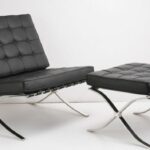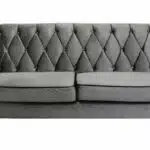As an upholstery repair technician, I have seen countless cases of sagging couches. Over time, the cushions and springs can lose their shape and support, leaving the once comfortable seating feeling worn out and uncomfortable. Many homeowners may assume that buying a new couch is the only solution, but with some simple techniques, it is possible to repair a sagging couch and extend its lifespan.
In this article, we will explore various methods for repairing a sagging couch. We will examine the causes of sagging and provide step-by-step instructions for fixing the issue. Whether you are dealing with a minor dip or a major sinkhole in your couch, these techniques can help restore your furniture to its former comfort and functionality. By following these tips, you can save money on costly replacements and enjoy your favorite seating for years to come.
Causes Of Sagging Couches
Potential customers may question why their couch is sagging in the first place. It’s a valid concern, as people want to prevent this from happening again. Sagging couches can be caused by a variety of factors, including age, overuse, and poor quality materials. Prevention methods include purchasing high-quality furniture with sturdy frames and avoiding excessive use.
Risk factors that contribute to couch sagging include body weight, frequency of use, and improper care. When too much weight is placed on a particular area of the couch repeatedly, it can lead to sagging in that spot over time. Additionally, frequent use without proper cushion maintenance or cleaning can cause the cushions to lose their shape and support.
It’s important to understand these causes and risk factors because they help identify ways to prevent future sagging. However, if your couch is already sagging, it’s essential to determine the severity of the issue before attempting any repairs.
Identifying The Severity Of The Sag
After understanding the causes of sagging couches, it is important to assess the severity of the sag before attempting any repairs. The degree of sagging will determine the course of action needed to fix the problem. One must evaluate whether it is a minor sag or a major one that needs professional attention.
Assessing the severity can be done by sitting on various areas of the couch and feeling for any noticeable differences in support or comfort. If there is significant sinking or discomfort, there may be a more serious issue with the underlying structure of the couch. Another way to check for severity is by examining the cushions themselves; if they appear worn out or misshapen, then chances are there is a deeper issue at play.
Prevention tips should also be kept in mind when assessing for severity. Regular maintenance such as flipping and rotating cushions, tightening screws or bolts, and avoiding overloading furniture can help prevent future damage and prolong the life of your couch. By identifying and addressing issues early on, you can prevent further wear and tear on your couch.
When assessing the condition of springs in a sagging couch, it is important to pay close attention to how they respond when pressure is applied. Springs that feel loose or squeak when compressed may need replacing. Additionally, examining spring clips for rust or damage can give insight into their overall condition. By properly identifying the severity of a sagging couch and taking preventative measures to maintain its structure, homeowners can ensure their furniture lasts for years to come without needing extensive repairs.
Assessing The Condition Of The Springs
- In order to assess the condition of the springs, it is important to check for any broken springs.
- The tension of the springs should also be inspected to ensure they are not too loose or too tight.
- Additionally, the support structure of the springs should be examined to determine if any additional support is needed.
- To check for broken springs, the upholstery should be carefully inspected for any damage or missing springs.
- To inspect the tension of the springs, the upholstery should be gently stretched to check for any instability in the springs.
- To examine the support structure, the upholstery should be inspected for any signs of damage to the frame or other supports.
Checking For Broken Springs
Upon first inspection of the sagging couch, it is important to check for broken springs. Broken springs can be a common cause of sagging in couches and can greatly affect the overall comfort and support of the furniture piece. To check for broken springs, one must feel along the bottom of the couch, looking for any noticeable dips or unevenness.
If a broken spring is found, it will need to be replaced in order to restore proper support to the couch. This process involves removing the old spring and installing a new one in its place. If multiple springs are broken, it may be necessary to replace all of them in order to ensure complete restoration of the couch’s functionality.
In addition to broken springs, it is important to also check for any damaged spring clips. Spring clips are small metal pieces that hold the springs in place and prevent them from shifting around within the couch. If these clips become damaged or bent out of shape, they may need repairing or replacing as well in order to properly restore support to the couch.
Inspecting The Tension Of The Springs
As an upholstery repair technician, assessing the condition of a couch’s springs is a crucial step in determining its overall functionality and comfortability. Common issues that can arise with the springs include broken or damaged pieces, as well as weak tension. While some DIY solutions may exist for simple issues such as reattaching a loose spring clip, it is important to know when to seek professional help and consider cost considerations.
Inspecting the tension of the springs involves feeling along the bottom of the couch to ensure that each spring is tightly secured in place. A lack of tension can cause sagging and discomfort for those using the couch, leading to potential long-term damage if not addressed promptly. If weak tension is detected, it may be necessary to adjust or replace the springs in order to restore proper support.
It is important for homeowners to carefully consider their options when dealing with spring-related issues. While DIY solutions may seem like a cost-effective option, improper repairs can lead to further damage and potentially more expensive repairs down the road. Seeking professional help from an experienced upholstery repair technician can ensure that all necessary repairs are completed correctly and efficiently, while also considering cost considerations for the homeowner.
Examining The Support Structure
As an upholstery repair technician, it is important to conduct a proper inspection of a couch’s support structure in addition to assessing the condition of its springs. The support structure includes the frame, legs, and any additional reinforcements that provide stability and durability. Common issues with the support structure include loose joints or broken pieces, which can lead to instability and potential safety hazards.
To properly inspect the support structure, one must start by examining the joints and connections where pieces are fastened together. Loose or wobbly joints should be tightened, while broken pieces may require replacement to ensure stability. Additionally, checking for any signs of wear or damage on the legs or other supporting components is crucial in preventing further damage.
Common solutions for addressing issues with a couch’s support structure include adding additional reinforcements or replacing damaged pieces entirely. As with assessing the condition of the springs, it is important for homeowners to carefully consider their options when dealing with these types of repairs. Seeking professional help from an experienced upholstery repair technician can ensure that all necessary repairs are completed correctly and efficiently while also considering cost considerations for the homeowner.
Checking The Cushions
When dealing with a sagging couch, it is essential to check the cushions. Replacing cushions may be necessary to bring back the couch’s original shape and firmness. However, before choosing new cushions, it is important to determine the right materials that will work best for your needs.
When selecting cushion materials, consider how often the couch is used and by whom. If children or pets frequently use the couch, choose more durable and stain-resistant materials. Additionally, consider the level of support needed; firmer foam will provide greater support but may not be as comfortable as softer foam. Polyester fiberfill is a popular cushion material due to its affordability and comfort level.
Replacing cushions can significantly improve the overall comfort of a couch. In some cases, however, simply replacing them may not fully resolve sagging issues. In these situations, reinforcing the frame may be necessary to prevent further sagging problems in the future.
Transition: With an understanding of cushion materials and their impact on overall support and comfort, it’s important to also inspect other areas of the couch that may contribute to sagging issues. The next step is to examine the frame for any potential reinforcement needs.
Reinforcing The Frame
Like a doctor examining a patient, the first step in repairing a sagging couch is to check the cushions. However, if the cushions are not the problem, then it’s time to move on to reinforcing the frame. This is an important step because even if you replace the cushions, they will eventually sag again if the frame is weak.
Using brackets and gluing joints are two effective methods of reinforcing a couch frame. The brackets can be attached to the corners of the frame for added support, while glue can be used to strengthen any loose joints. These techniques are often preferred over replacing parts of the frame because they are cost-effective and preserve the original structure of the couch.
Cost-effective frame repair solutions are essential for those who want to save money while still maintaining their furniture’s integrity. Reinforcing a sagging couch frame with brackets and glue is an excellent way to do this. By ensuring that your couch has proper support, you can prolong its lifespan and avoid costly repairs down the road.
As we move forward in our quest to repair a sagging couch, it’s important not to forget about tightening loose screws and bolts. This final step will ensure that everything is secure and stable before moving on to enjoying your newly repaired piece of furniture.
Tightening Loose Screws And Bolts
To tighten loose screws and bolts is an essential first step in repairing a sagging couch. Common mistakes made when attempting this repair include using the wrong size screwdriver or wrench, failing to remove debris from the screw’s threading, and over-tightening screws or bolts. These mistakes can lead to stripped screws, stripped threading, or further damage to the couch’s frame.
Before beginning the tightening process, it is important to gather the necessary tools. A Phillips head screwdriver or adjustable wrench may be required depending on the type of hardware used on the couch. It is also advisable to have a flashlight on hand for better visibility in hard-to-see areas. Once equipped with these tools, inspect all visible screws and bolts for looseness and tighten them as needed.
It is important to note that while tightening loose screws and bolts can improve a sagging couch’s stability, it may not fully resolve the issue if broken or worn springs are present. In such cases, replacing broken or worn springs will be necessary to restore proper cushion support and prevent further damage to the couch’s frame.
Replacing Broken Or Worn Springs
As a professional upholstery repair technician, I have seen my fair share of sagging couches. One common culprit behind this problem is broken or worn springs. Springs act as the support system for your couch, and they play a crucial role in keeping it sturdy and comfortable for years to come. To illustrate their importance, think of your couch as a car – just as a car’s suspension system keeps you from feeling every bump in the road, your couch’s springs keep you from feeling every movement on the surface.
If you’re experiencing sagging or discomfort when sitting on your couch, it may be time to consider spring replacement. While some people prefer to take the DIY route, it’s important to note that replacing springs can be a complex and time-consuming process that requires specialized tools and expertise. Hiring a professional can ensure that the job is done correctly and efficiently, so you can enjoy a fully functional couch without any hassle.
When it comes to spring replacement, there are various types of springs available in the market. Each type has its own pros and cons depending on factors such as durability, cost, and comfort level. For instance, coil springs are known for their long-lasting quality but may not provide enough support for heavier individuals or those with back problems. On the other hand, sinuous springs offer excellent support but tend to wear out quickly over time. As an upholstery repair technician, I can help you choose which type of spring will work best for your specific needs and preferences.
By now, you should have a better idea of how important springs are for keeping your couch comfortable and durable for years to come. If you’re considering spring replacement, be sure to weigh the benefits of DIY versus professional help and carefully evaluate which type of spring would work best for your needs. In the next section, we’ll discuss another way to enhance your couch’s comfort – adding extra padding to cushions.
Adding Extra Padding To Cushions
To add extra padding to sagging couch cushions, the first step is to assess the current condition of the cushions. If they are severely worn or damaged, it may be necessary to replace them entirely. However, if they are still in decent shape but simply lacking in support, adding foam can help restore their shape and firmness.
To begin, measure the dimensions of each cushion and purchase foam inserts that are slightly larger than those measurements. Cut the foam down to size using a sharp pair of scissors or a utility knife. Then, remove the cushion covers and insert the foam into each cover. Be sure to smooth out any wrinkles or bumps in the cover before zipping it closed again.
If you don’t want to replace your cushion covers entirely, you can also add a layer of batting or fiberfill between the original cushion and new foam insert for extra comfort. This will help create a softer feel while still providing ample support. With these simple steps, you can easily add extra padding to your sagging couch cushions and make them feel like new again.
Transition into subsequent section: While adding foam can be an effective way of restoring sagging cushions, sometimes it is not enough on its own. In cases where the cushions have lost too much fill over time, restuffing may be necessary for optimal results.
Restuffing Cushions
After adding extra padding to the cushions, you may still find that your couch is sagging. This can be due to worn out cushion foam, which is a common problem in older furniture. Before you decide to throw out your beloved couch, consider replacing the cushion foam.
Choosing upholstery for a couch can be an overwhelming task. There are countless options available, from leather to cotton to microfiber. However, when it comes to replacing cushion foam, it’s important to choose an upholstery fabric that is durable and can withstand daily wear and tear. An experienced upholsterer can guide you through the selection process and help you choose a suitable fabric.
Foam replacement options include high-density foam, memory foam, and down feathers. Each option has its own benefits and drawbacks. High-density foam is firm and provides good support, but may not be as comfortable as memory foam or down feathers. Memory foam molds to your body shape for optimal comfort but may not last as long as high-density foam. Down feathers provide superior comfort but require frequent fluffing and maintenance. Consider your needs and preferences when choosing cushion foam replacement options.
In order to restore your sagging couch back to life, replacing the cushion foam is essential. With the right choice of upholstery fabric and foam replacement option, you can enjoy the comfort of your newly revamped couch for years to come.
Replacing Cushion Foam
When repairing a sagging couch, one of the most common causes is worn-out cushion foam. Upholstery fabric cannot provide proper support without the right density of foam. Therefore, replacing cushion foam is a necessary step to ensure the longevity and comfort of your couch.
To replace cushion foam, there are certain steps you need to follow. First, remove the old foam by cutting it off with a sharp knife or scissors. Then, measure the dimensions of your couch cushions and purchase foam that matches those measurements. When selecting new foam, consider its density and firmness level to ensure maximum support.
Here are some tips for choosing the right foam:
- Look for high-density foam that will not break down easily over time.
- Consider the firmness level based on your personal preference and how often you use your couch.
- Check if the foam has fire-retardant properties to comply with safety regulations.
- Opt for foam that is easy to clean and maintain.
Replacing cushion foam can be a DIY project but it’s always best to consult with an upholstery repair technician for professional advice. With new cushion foam in place, your couch will regain its shape and offer better support for years to come.
Transition: Now that you have replaced your cushion foams with high-density ones, let’s move onto another solution in providing added support using furniture braces.
Using Furniture Braces For Added Support
Furniture brace installation is a viable solution for adding extra support to a sagging couch. When installed correctly, furniture braces can help reinforce the frame of your couch and prevent further damage. The benefits of added support are numerous; not only will it make your couch more comfortable, but it will also extend its lifespan.
To install furniture braces, you will first need to remove any cushions or fabric covering the base of your couch. Then, locate the weak points in the frame by checking for areas that are visibly sagging or creaking when pressure is applied. Once you have identified these areas, position the braces on either side of the weakened joint and secure them using screws or nails.
The added support provided by furniture braces can significantly improve the structural integrity of your couch. However, if the problem persists, it may be necessary to consider additional reinforcement options such as plywood installation. In this next section, we will explore how using plywood can further enhance the strength and durability of your couch’s frame.
Using Plywood To Reinforce The Frame
- Accurately measuring the frame of the couch is necessary to properly reinforce it with plywood.
- Plywood should be cut to the size of the frame, allowing for 1/4 inch extra space for the upholstery.
- The plywood should be sanded and stained to match the finish of the couch, if possible.
- Holes should be drilled into the frame and plywood, and the two pieces should be fastened together with screws.
Measuring The Frame
As an upholstery repair technician, I understand the frustration of a sagging couch. It can be uncomfortable and unsightly, making it difficult to relax or entertain guests. However, before reinforcing the frame with plywood, it’s important to measure the dimensions of the frame to ensure proper fit.
The first step in measuring the frame is determining its length and width. This can be done by using a tape measure or ruler and taking accurate measurements from one end of the frame to the other. Additionally, it’s important to adjust for any curves or angles in the frame that may affect its dimensions.
Next, it’s important to measure the height of the frame. This will determine how thick your plywood should be when reinforcing the structure. Again, use a tape measure or ruler to take accurate measurements from the bottom of the frame to the top.
By accurately measuring and adjusting for any variations in the frame’s dimensions, you can ensure that your reinforcement with plywood will fit snugly and provide long-lasting support. Remember, taking time to measure properly now will save you time and frustration down the road.
Preparing The Plywood
Once you have measured the dimensions of the frame accurately, it’s time to move on to the next step of reinforcing it with plywood. Before you start cutting your plywood, ensure that you have selected a thickness that matches the height of the frame. This will provide maximum support and prevent future sagging issues.
The cutting process for plywood is straightforward but must be done with precision to avoid any errors or waste. First, measure and mark the dimensions of the frame onto the plywood sheet using a pencil and ruler. Next, use a circular saw to cut along the marked lines. If you don’t have access to a saw or are uncomfortable using one, you can also use a jigsaw or handsaw. Once your pieces are cut, sand them lightly to remove any rough edges before attaching them to the frame.
When attaching plywood to reinforce the frame, there are several methods you can use depending on personal preference and access to tools. One common method is using wood glue and screws. Apply wood glue generously onto both sides of each piece of plywood before securing them into place with screws every few inches along each edge. Another method involves using metal brackets or braces on either side of each corner for added stability. Regardless of which method you choose, ensure that all screws or brackets are flush against the surface and not protruding outward where they could cause injury or damage upholstery fabric in case someone sits on it directly over those areas.
Reupholstering The Couch
To reupholster a couch, the first step is to choose the fabric you want to use. It is important to select a fabric that is durable and easy to maintain. You can choose from a variety of fabrics such as cotton, linen, leather or microfiber. When selecting your fabric, consider how it will look in your living room with the other furniture and décor.
Once you have chosen your fabric, the next step is to remove the old upholstery. This process requires careful attention to detail so that you do not damage the frame or any of the cushions. Once you have removed all of the old upholstery, you will need to cut your new fabric according to your measurements and attach it securely.
Cost comparison is an important consideration when deciding whether or not to reupholster your couch. While it may be less expensive than buying a brand new couch, the cost can still add up quickly depending on the size and complexity of your project. However, reupholstering allows for customization options and can extend the life of your furniture for years to come.
When considering reupholstering your couch, it is important to weigh all of these factors carefully before making a decision. If you are unsure about tackling this project yourself or if you do not have enough time or resources, consider hiring a professional upholstery repair technician who can guide you through the process and ensure that your couch looks its best.
Hiring A Professional Upholstery Repair Technician
While DIY alternatives can be tempting, it is important to consider the potential risks involved with attempting to repair your couch yourself. Many people may believe that fixing a sagging couch is a simple task that can be accomplished with a few quick online tutorials, but this is not always the case. In fact, attempting to fix your couch without proper training and experience can lead to further damage or even injury.
If you are considering hiring a professional upholstery repair technician, it is important to understand the potential costs involved. While prices can vary depending on the extent of the damage and the specific services needed, it is generally more expensive than attempting to fix the problem yourself. However, investing in professional repair services can provide peace of mind and ensure that your couch is repaired correctly.
Here are three reasons why hiring a professional upholstery repair technician may be worth the cost:
- They have specialized knowledge and expertise in repairing furniture.
- They use high-quality materials and tools to ensure long-lasting repairs.
- They can provide additional services such as cleaning and maintenance tips.
By hiring a professional upholstery repair technician, you can ensure that your couch is properly repaired and maintained for years to come. However, it’s also important to remember that there are DIY alternatives available for those who prefer a more hands-on approach. Regardless of which route you choose, taking care of your couch now will help prevent future sagging issues down the line.
Maintaining Your Couch To Prevent Future Sagging
Hiring a Professional Upholstery Repair Technician is an excellent option for those who want to ensure that their couches are repaired in the best possible way. However, there are several things that you can do to maintain your couch and prevent future sagging. It’s essential to take good care of your furniture so that it lasts for a long time.
Preventing sagging is one of the most critical aspects of maintaining your couch. To do this, you should avoid placing heavy items on the cushions or sitting in the same spot repeatedly. Rotate the cushions regularly to distribute weight evenly, and avoid jumping on them. Additionally, you should refrain from putting pressure on the arms as they may weaken over time.
Cushion maintenance is another crucial aspect of taking care of your couch. You should fluff up the cushions regularly and vacuum them to remove any dirt or debris that can accumulate over time. If you spill something on your couch, clean it up immediately with a damp cloth and mild soap. By following these simple steps, you can keep your couch looking like new for years to come.
| Maintenance Tips | Frequency | Tools Needed |
|---|---|---|
| Fluff up cushions | Weekly | Hands |
| Vacuuming cushions | Monthly | Vacuum cleaner |
| Rotating cushion placement | Every 3 months | Hands |
| Spot cleaning spills/stains | As soon as possible after spill occurs | Damp cloth and mild soap |
Maintaining Your Couch to Prevent Future Sagging is essential if you want your furniture investment to last long-term. By preventing sagging and maintaining cushion quality, your sofa will stay comfortable and stylish for years to come. Remember these tips when caring for your furniture: no heavy items on cushions, rotating cushion placement often, regular cushion maintenance including fluffing/vacuuming, keeping arms free from pressure points and spot cleaning spills immediately with a damp cloth/mild soap solution.
Conclusion
Sagging couches are a common problem that can occur due to various reasons. Identifying the severity of the sag and assessing the condition of the springs and cushions is crucial before initiating any repair work. Reinforcing the frame with plywood can help prevent future sagging, while reupholstering the couch can give it a fresh look.
However, it is important to acknowledge that repairing a sagging couch is not always an easy task and may require professional expertise. Hiring a qualified upholstery repair technician can ensure that your couch gets repaired properly without causing any further damage. Additionally, maintaining your couch regularly through proper cleaning and care can prevent future sags from occurring.
As a professional upholstery repair technician, I understand how important it is for you to have a comfortable and well-maintained couch in your home. Therefore, it is my duty to provide you with the best possible service to ensure that your couch remains in good condition for years to come. By following these tips and seeking professional help when needed, you can keep your couch looking great and feeling comfortable for many years.
Image Credits
- “May 11, 2013 Farewell my prince” by Dreaming in the deep south (featured)





























